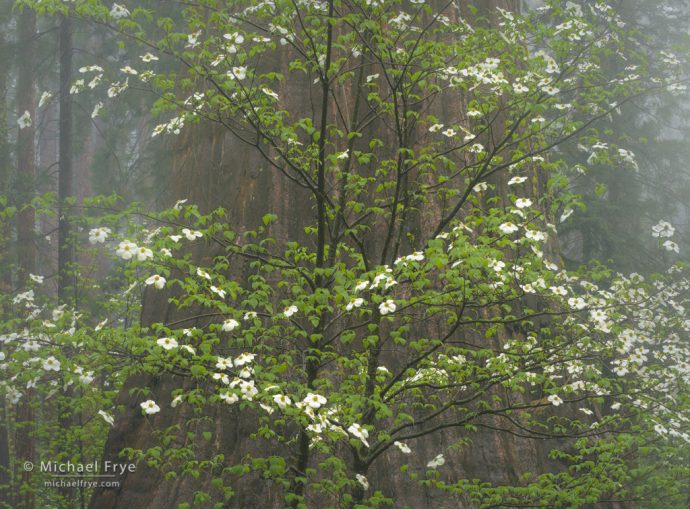
Dogwood and giant sequoia in the fog, Sierra Nevada, California. Fog is a wonderful complement to forest scenes; here, some ephemeral fog lasted just long enough for me to capture this image. 70mm, polarizer, 0.7 seconds at f/16, ISO 100.
People seem to love trees and forests. I know I do.
But forests can be difficult to photograph. Natural forests are usually a study in chaos, with haphazard arrangements of branches, trunks, logs, and leaves. There’s an organic order to all that, with trees and understory plants growing to take advantage of small patches of sunlight, and a cycle of birth, growth, death, and decay.
But visual order can be hard to find amid all that clutter. The chief challenge in photographing forests is usually finding a way to simplify things, and make order out of chaos.
Stand Back
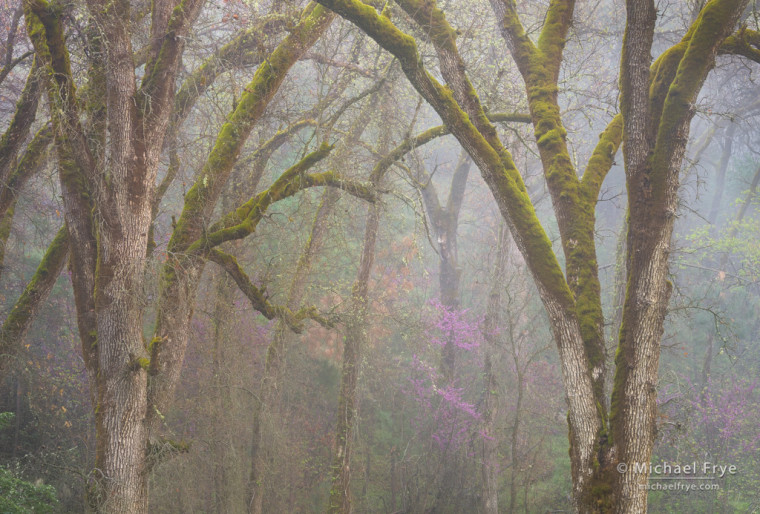
Oaks and redbuds in the fog, Mariposa County, Stanislaus NF, California. A small man-made clearing allowed me to step back and use a long lens to photograph this scene without foreground branches getting in the way. 116mm, polarizer, 0.7 seconds at f/11, ISO 100.
I’m sure you’ve heard the expression, “You can’t see the forest for the trees.” Any photographer trying to photograph a forest will recognize the truth in that statement. I can’t tell you how many times I’ve found an otherwise-perfect composition ruined by intervening branches or leaves. Sometimes I can put the camera on my tripod, compose, set a 10-second self timer, then walk out and gently bend the offending branches out of the way. But often that’s not possible, and I have to look for a different composition.
And what I usually look for is a place where I can step back from the forest a bit, without intervening trees or branches in the way. That means finding a small clearing or break in the forest, like a meadow, field, creek, road, or trail. Sometimes I can climb on top of a log or embankment to get above the foreground clutter. Although it’s possible to find good compositions in the middle of a busy forest, it usually helps to stand back a little bit and get some perspective.
Look for Order
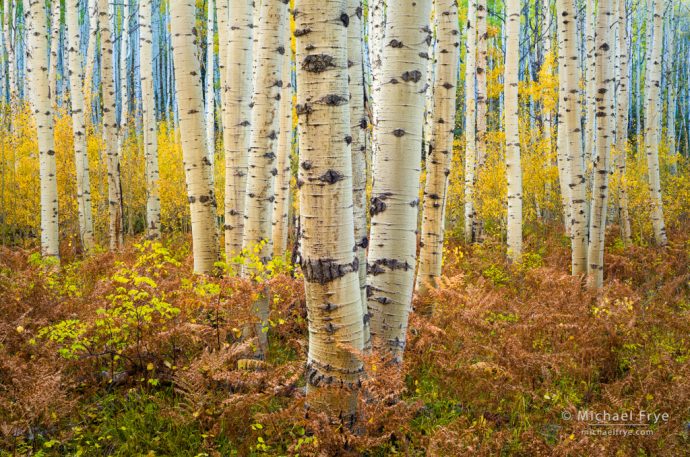
Aspens and ferns, autumn, Grand Mesa-Uncompahgre-Gunnison NF, Colorado. The trunks in the center provide a focal point, while numerous repeating patterns (vertical trunks, black spots on the trunks, horizontal layers of color) help provide visual cohesion. A small, fern-filled opening in the forest allowed me to step back a little from the trees and get some perspective. 50mm, 1/3 sec. at f/16, ISO 100.
Since forests are chaotic, you have to simplify. That means, first of all, resisting the temptation to include everything. You don’t need to show a whole tree to convey the idea of a tree. You don’t need to show a hundred trees to convey the idea of a forest. Try to narrow your composition down to the bare essentials.
And look for order amid the chaos. That means finding patterns and strong visual focal points. The focal point could be one tree that stands out in some way, a spot of light hitting a fern, or the sun edging out from behind a trunk. A pattern could be a series of vertical trunks, or repeating diagonal branches, or a pointillist arrangement of leaves.
Use Light to Simplify
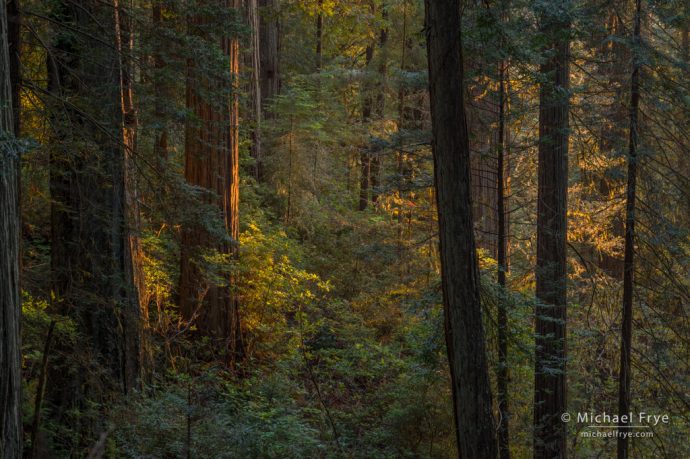
Late-afternoon light in a redwood forest, Northern California. When sunlight streams through a forest it creates dappled, splotchy light that can be extremely difficult to deal with. It can sometimes work, however, when the sun spotlights an interesting focal point, like the trunk on the left side of this photograph. Here the light is also warmed by the setting sun, and it’s coming more from behind than the side, so the trees are partially silhouetted. Dappled frontlight in a forest is much more troublesome. 135mm, polarizer, 8 seconds at f/11, ISO 100.
Finding the right light is essential for forest scenes. You want to use light that helps to simplify the scene, which usually means avoiding frontlight and sidelight, and instead using backlight and soft light.
Inside a forest, frontlight (the sun at your back) creates splotchy patterns that add to the visual confusion. As the sun filters through the trees, random patches of sun and shade break up the shapes of trunks and branches, obscuring whatever order there might be. Sidelight can be a little better, but it’s still usually challenging to work with. Of course there are always exceptions, and this dappled light can sometimes work when the sun filters through the trees and spotlights a particularly interesting forest feature. But those instances are rare.
Backlight and soft light usually work better. With backlight, trunks and branches become dark silhouettes that stand out more cleanly and distinctly from the background, which makes it easier to show patterns and create some order. And soft light keeps things as simple as possible, because there are no random patches of sun and shade to break up the natural patterns.
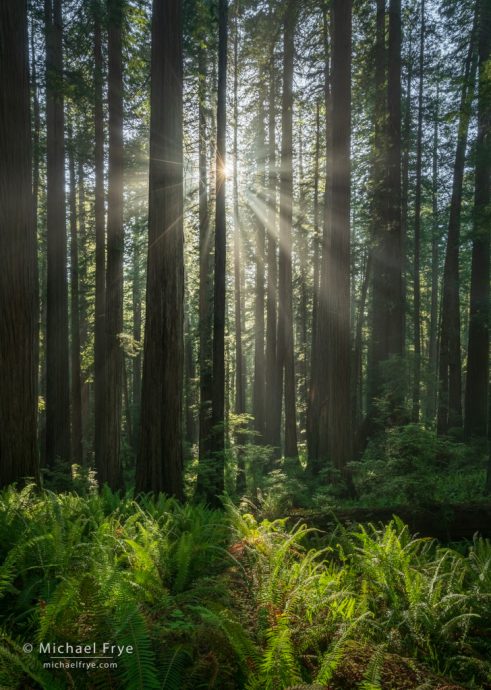
Redwoods, ferns, and sunbeams, northern California. Backlight turned the redwood trunks into silhouettes, which makes the repeating pattern of vertical lines stand out clearly. Backlight also works well with translucent objects, like the foreground ferns. There’s a primary focal point (the sun), and a secondary focal point (the ferns), along with the repeating patterns – which all help to create visual unity and cohesion, and make a busy forest scene “read” clearly. The ferny glade in the foreground created a small clearing and allowed me to get some distance between the camera and the trees. 24mm, five bracketed frames, each at f/16 and ISO 200, blended with Lightroom’s HDR Merge.
With soft light there are, however, some thing to watch out for. First, any patches of sky that show through the trees will be much brighter than the shaded forest, drawing the viewer’s eye to those bright patches – which is probably not what you want. So when photographing a forest in the shade I avoid looking up toward the sky, and instead try to find elevated vantage points where I can look down into the forest, or else try to put a hillside or mountain behind the trees. This often means using telephoto lenses to narrow the angle of view and keep the sky out of the picture.
Also, soft light is low in contrast, which can makes images look flat, so the subject itself has to provide the contrast. That could mean juxtaposing light and dark objects, like white dogwood flowers against a dark trunk. Or it could mean using color contrast rather than light-and-dark contrast. Soft light is often the perfect way to accentuate the colors of an autumn forest.
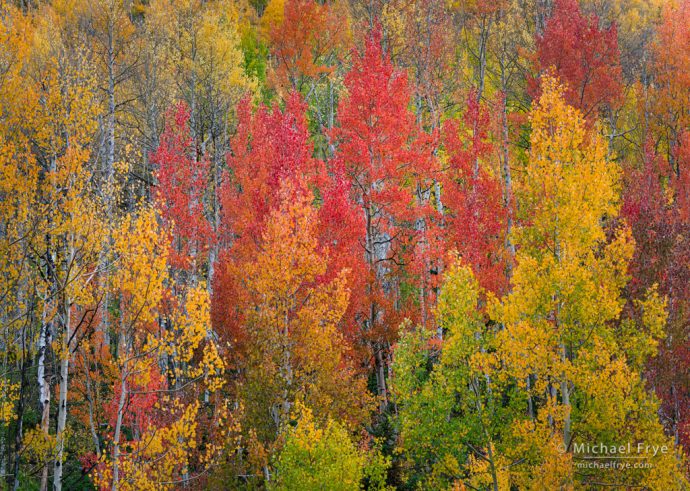
Aspen kaleidoscope, Uncompahgre NF, Colorado. Soft light helps to visually simplify busy forest scenes, and bring out color contrasts. The center-right clump of red trees here provided a focal point, and there were several unifying patterns: the flame-like tree tops, the repeating vertical lines of the trunks, and the multi-colored polka dots of the leaves. A small clearing next to a road allowed me step back, use a long lens, and find the patterns. 106mm, polarizer, 1/4 sec. at f/16, ISO 400.
But what I hope for, and dream of, is fog. Fog is the ultimate simplifier, blotting out background clutter. And I love the misty, primeval mood it adds to forest scenes. Even frontlight and sidelight breaking through the fog can be beautiful, while backlight often creates spectacular sunbeams.
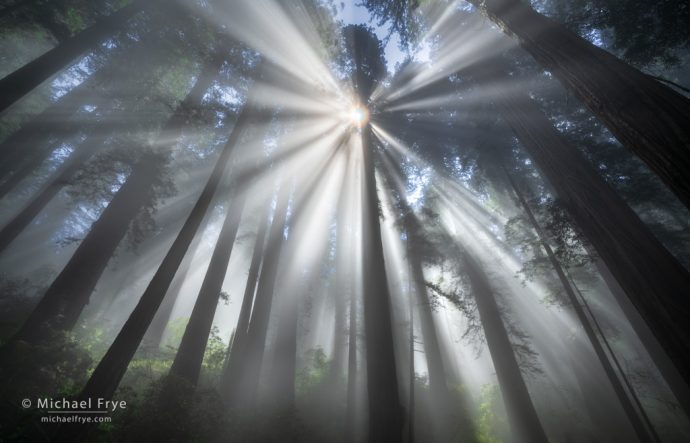
Sunbeams in a redwood forest, northern California. Fog in a forest can be magical – especially when the sun breaks through the fog. The sun is a strong focal point here, and the numerous diagonal lines form repeating patterns that help unify and simplify the composition. 16mm, five bracketed frames, each at f/11, ISO 100, blended with Lightroom’s HDR Merge.
* * *
Yosemite is still closed, and we had to cancel our annual redwoods workshop, so Claudia and I haven’t been able to get to some of our favorite forests recently. But we did manage to photograph a giant sequoia grove on national forest land this spring (the photograph at the top of this post), and hope to get up to the redwoods sometime during the summer fog season.
— Michael Frye
Related Posts: The Primeval Forest; Dogwood Composition
Michael Frye is a professional photographer specializing in landscapes and nature. He is the author or principal photographer of The Photographer’s Guide to Yosemite, Yosemite Meditations, Yosemite Meditations for Women, Yosemite Meditations for Adventurers, and Digital Landscape Photography: In the Footsteps of Ansel Adams and the Great Masters. He has also written three eBooks: Light & Land: Landscapes in the Digital Darkroom, Exposure for Outdoor Photography, and Landscapes in Lightroom: The Essential Step-by-Step Guide. Michael has written numerous magazine articles on the art and technique of photography, and his images have been published in over thirty countries around the world. Michael has lived either in or near Yosemite National Park since 1983, currently residing just outside the park in Mariposa, California.









Thank you, Michael, this is very helpful! I must admit I really struggled when I was attempting to photograph the redwoods at Jedediah Smith last July; most of my images were pretty lackluster. I was hoping to get back there this year, but I’m going to have to cancel my flight to SFO, which was scheduled to leave on June 24. It’s just not the time to fly from Italy to the U.S. I just love the photo at the top of your post—my sister tells me the dogwood is blooming now in Plumas County and is just beautiful this year. I hope all is well with you and Claudia.
You’re welcome Bob, and thanks – I’m glad you like the dogwood photo. Part of your issue might have been that the groves in Jedediah Smith are not as fog-prone as some other redwood groves, since it’s further from the ocean. But I have made some nice photos in Jed Smith with soft light and backlight. It helps to have the rhododendrons in bloom also.
The real beauty of nature is revealed in your pictures. I’m also using one of these on my desktop wallpaper. It is very difficult to capture the beauty of nature through the lens that you have shown. Thank you, Michael.
Thanks so much Joy!
Thank you, Michael, for another thoughtful article. I’ll have to go back and analyze my forest photos for the light. I did break out into a grin when you mentioned that you hope for and dream of fog, because I know my favorite photos of the forest preserves around my area have been taken in foggy conditions.
You’re welcome Vivienne – I’m glad you enjoyed this. Fog makes such a big difference in forests.
Your ability to articulate what your looking for in a photograph is an art in itself!
Thanks Tom!
Great article Michael. I also prefer backlight and foggy days for forest photography. Furthermore, I’m using much more often the normal and telephoto zoom range than the wideangle zoom range in the forest.
Thanks Michael – I’m glad to hear that those ideas are working for you.
Amazing photos! I am heading for Yosemite, and everyone tells me that summer is not the best time to go. Unfortunately it is the only time I have. Thanks for the great tips!
Thanks Jesse! At least summer will be less crowded than usual this year. In case you didn’t already know this, Yosemite is requiring reservations for anyone entering the park from now until the end of October. You have to have either a lodging or camping reservation inside the park, or a day-use reservation. And the high country is great in summer.